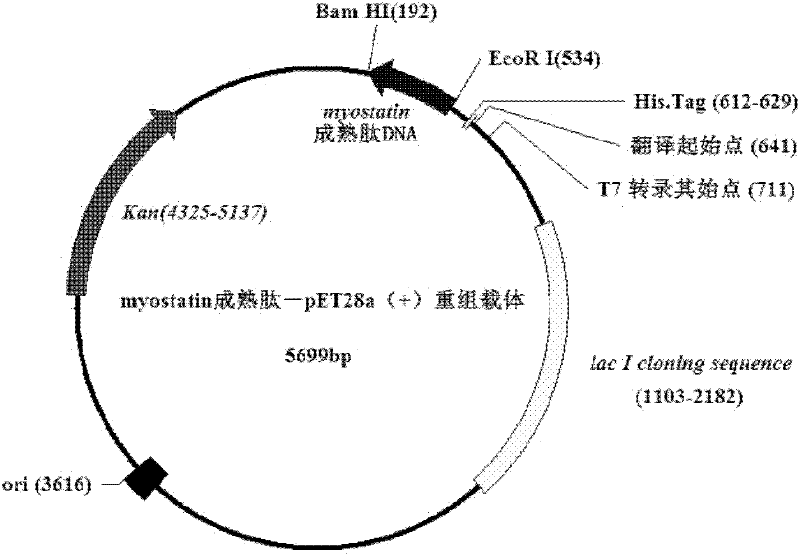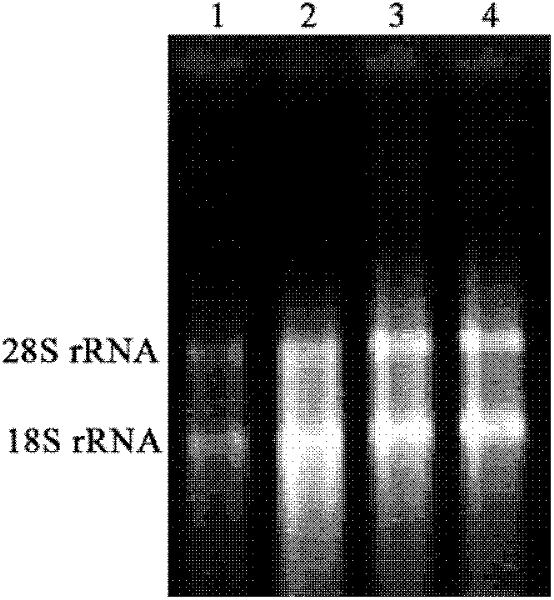Tibetan sheep myostatin recombinant expression protein
A technology of hiding sheep and protein, applied in the field of genetic engineering, can solve problems such as overexpression of propeptide, lower survival rate of calves, and impact on animal heart load
- Summary
- Abstract
- Description
- Claims
- Application Information
AI Technical Summary
Problems solved by technology
Method used
Image
Examples
Embodiment 1
[0114] Example 1, construction of Tibetan sheep pET28a(+)-MSTN' recombinant vector
[0115] 1. Primer design
[0116] According to the sheep myostatin gene sequence (AF019622), use Vector NTI software to design myostatin coding gene primers, and the primer sequences are as follows:
[0117] Upstream primer P1: 5′-ATGCAAAAACTGCAA-3′
[0118] Downstream primer P2: 5′-TCATGAGCACCCCACAGCGATCTACT-3′
[0119] 2. RT-PCR amplification of Tibetan sheep myostatin fragment
[0120] (1) RNA extraction from Tibetan sheep leg skeletal muscle
[0121] According to the total RNA extraction method provided by Invotrogen, the total RNA of Tibetan sheep leg skeletal muscle was extracted according to the following steps:
[0122] ①Take 50-100 mg of Tibetan sheep leg skeletal muscle tissue stored at -70°C, shred it, transfer it to a 20 mL homogenizer with 1 mL Trizol added in advance, and homogenize until the cells are completely lysed;
[0123] ② Transfer the homogenized liquid into a 2mL ce...
Embodiment 2
[0196] Example 2, expression of Tibetan sheep pET28a(+)-MSTN'-E.coli BL21(DE3) genetic engineering bacteria
[0197] 1. Construction of Tibetan Sheep pET28a(+)-MSTN′-E.coli BL21(DE3) Genetic Engineering Bacteria
[0198] The pET28a(+)-MSTN' recombinant vector was transformed into Escherichia coli BL21(DE3) host bacteria, and the specific operation steps were the same as the transformation operation in the Sanzang sheep myostatin clone in step 1 of the above-mentioned Example.
[0199] 2. IPTG induces the expression of pET28a(+)-MSTN'-E.coli BL21(DE3) genetic engineering bacteria
[0200] (1) Pick a single recombinant bacterium and inoculate it in LB medium, culture overnight at 37°C and 120rpm with shaking, the volume ratio of genetically engineered bacteria solution to LB medium is 1:100, and use the bacterial sample containing empty vector as a control ;
[0201] (2) The next day, the activated seed bacteria of the experimental group and the control group were inoculated i...
Embodiment 3
[0209] Example 3, Tibetan sheep MSTN mature peptide protein purification
[0210] 1. Inclusion body isolation
[0211] (1) The expression bacteria induced by IPTG were centrifuged at 12000r / min at 4°C for 15min to collect the bacteria;
[0212] (2) Add PBS buffer solution to the cells, add 10 mL of wet weight of 1 g cells, resuspend the cells, and wash twice;
[0213] (3) The bacterial cell suspension was placed on ice for 20 minutes and ultrasonically crushed, broken for 5 seconds, interrupted for 9 seconds, centrifuged at 12000 r / min at 4°C for 15 minutes, and the precipitate was collected;
[0214] (4) Add PBS buffer containing 0.1% Triton X-100 to resuspend the pellet, add 20 mL of buffer to the wet weight of 1 g of bacteria, let stand at 4°C for 20 min, and wash repeatedly 5 times;
[0215] (5) Wash the inclusion body 5 times with PBS buffer containing 2M urea in the same way, centrifuge at 12000r / min at 4°C for 15min, and collect the precipitate;
[0216] (6) The wash...
PUM
| Property | Measurement | Unit |
|---|---|---|
| molecular weight | aaaaa | aaaaa |
| melting point | aaaaa | aaaaa |
Abstract
Description
Claims
Application Information
 Login to View More
Login to View More - R&D
- Intellectual Property
- Life Sciences
- Materials
- Tech Scout
- Unparalleled Data Quality
- Higher Quality Content
- 60% Fewer Hallucinations
Browse by: Latest US Patents, China's latest patents, Technical Efficacy Thesaurus, Application Domain, Technology Topic, Popular Technical Reports.
© 2025 PatSnap. All rights reserved.Legal|Privacy policy|Modern Slavery Act Transparency Statement|Sitemap|About US| Contact US: help@patsnap.com



